Humanity has been looking at the stars since its earliest days, and some of the greatest leaps in science have come as a result of stargazing. Indeed, astronomy was at the heart of the origin of what we now know as the scientific method, with such names as Flamsteed, Newton, Halley, Wren and Boyle involved in producing what was then the most comprehensive star catalogue, listing the positions of 3,000 stars.
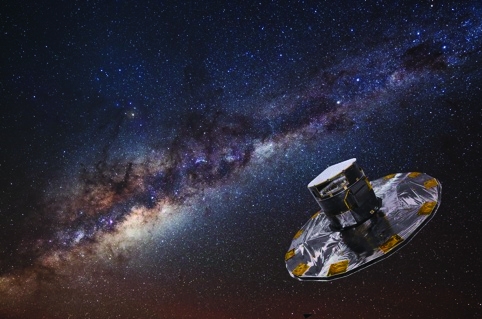
Position is vital for astronomy — you can’t study a star if you can’t find it. The science of star position is called astrometry and it’s still a subject of intense research as we try to expand our understanding of our home galaxy, the Milky Way, and its history.
Like much astronomy, astrometry is now carried out by a combination of ground-based and space telescopes, and the latest astrometry mission will be carried out from space. A new space telescope called Gaia is currently undergoing its final preparations at EADS Astrium’s cleanroom in Toulouse, before it is shipped out to the European Space Agency’s launch site in Kourou, French Guiana, before going into service atop a Soyuz rocket.
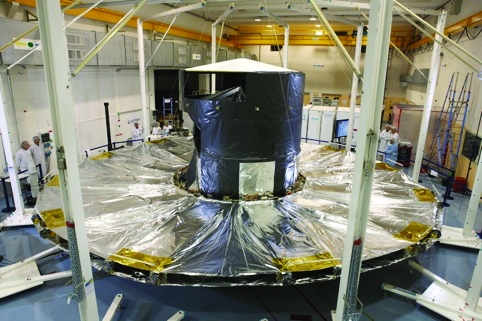
Gaia represents a huge leap in astrometry. Its immediate predecessor, Hipparcos, measured the positions of two million stars during its mission in the early 1990s. Gaia’s five-year mission will see it using a matched pair of telescopes to locate a billion stars, constructing the most detailed three-dimensional map of the Milky Way ever. Even this achievement will leave the vast majority of the galaxy as unmapped — a billion stars represents around one per cent of the total number in the Milky Way.
Like any scientific space mission, Gaia represents a series of firsts and superlatives. Its mirrors and optical bench — the structure its optical components are fixed to — are all made from the ceramic material silicon carbide, making it the largest SiC instrument ever flown. Its light-detecting sensors, made up from 106 charge-coupled devices (CCDs) mounted in a rectangular frame, make up the largest focal-plane array ever sent into space. It uses a new type of thruster to make minute corrections to its course without generating vibrations that could ruin its observations, and the information it will gather over the course of its mission represent one of the most challenging data-analysis projects ever.
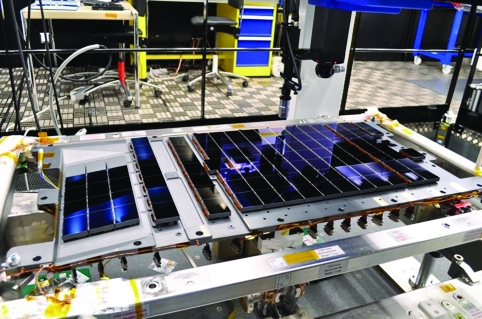
This combination of technologies adds up to an instrument of extreme sensitivity. Gaia’s optics are capable of detecting an object the width of a human hair — around 17µm — from a distance of a thousand kilometres. This will allow it to not only detect and map extremely distant stars, but will also mean it will be able to spot the small movements of stars caused by planets rotating around them, thereby adding to the available techniques for detecting exo-planets.
This extreme sensitivity was the overriding factor in the spacecraft’s design. Despite its spinning, tumbling course around its orbital (see ‘Orbital manouevres’ box), stability is everything to an optical instrument that can detect such minute detail. In this case, stability doesn’t mean stillness; it means that all the system’s optical components must retain their positions relative to each other within excruciatingly fine tolerances.
For the Astrium team building the satellite, at its locations in the UK, France, Germany and Spain, and its 50 subcontracting companies supplying components and subsystems, this posed a series of challenges. The need for stability dictated the choice of silicon carbide as the material for the mirrors and optical bench: strong, about twice as rigid as steel, and lightweight, it is also remarkably resistant to expansion and contraction under changes of temperature.
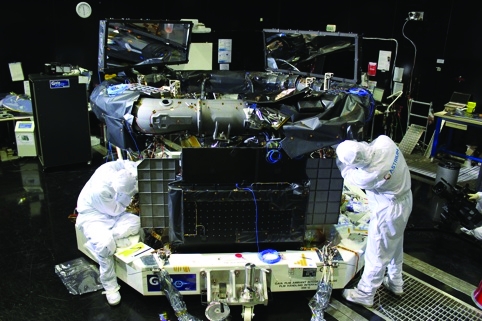
Gaia contains two telescopes, with primary mirrors set at an angle of 106.5° to each other. These primaries, unlike the circular mirrors familiar from ground-based telescopes or space telescopes such as Hubble or Herschel, are rectangular in shape, 1.46m wide and 0.51m deep and convex. These each reflect light onto a pair of convex mirrors measuring 0.35m x 0.16m, which bounce the light onto another pair of concave mirrors and then onto a pair of flat mirrors. These combine the light from the two telescopes through another pair of flat mirrors so that the images from both fall together onto the focal plane array. This tortuous light path means that the effective focal length of the telescopes is 35m, despite the entire spacecraft’s payload module being only 3.5m in diameter; this long focal length is instrumental in the telescopes’ ability to see objects 400,000 times fainter than those visible to the naked eye.
The mirrors were all made by Boostec, a specialist company located not far from Toulouse, where they were sintered from powdered SiC and ground so that their surfaces were flat.They were then sent on to another specialist, German firm Shunck Kohlenstofftechnik, where they were coated with a fine layer of SiC by chemical physical vapour deposition; this layer, applied extremely evenly, could then be polished down to the extremely high-quality finish required, around 10nm RMS — for comparison, if the primary mirror were expanded to the size of the Atlantic Ocean, any imperfections on its surface would be a few centimetres high. Finally, additional layers of an enhanced silver coating were added using a process called physical vapour deposition.
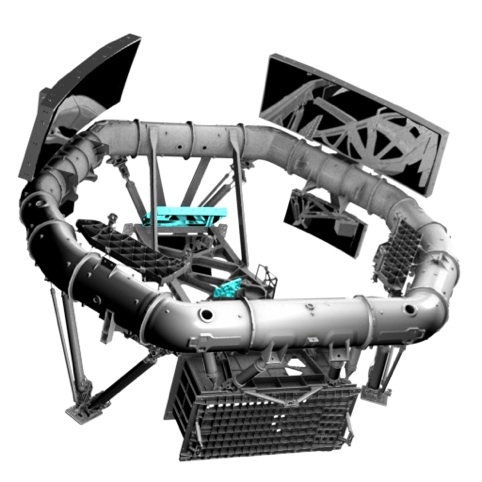
The focal plane array onto which these mirrors send their image consists of almost a billion pixels. The 106 CCDs from which it is composed were made by UK firm e2v, which has supplied most of the CCDs for space telescopes. The Chelmsford-based company produced a total of 174 CCDs for the project, including spares and engineering test models; each is 1,966 x 4,500 pixels and 45mm by 59mm. The array on Gaia itself, mounted onto a SiC frame, occupies an area of just under half a square metre.
Not all of the CCDs are dedicated to composing the spacecraft’s final image. As both telescopes send their image to the same array, a strip of CCDs along the side of the array the image hits first work to detect which image came from which telescope, and to use this information to remove redundant images from the signal that is sent back to Earth.
The optical bench to which the 10 mirrors and focal-plane array are attached is another SiC construction, a toroidal structure that locks all the components into place with picometre (a thousandth of a nanometre) precision. Developed at the Dutch research organisation TNO, the optical bench presented some specific problems, according to TNO business development director Ben Braam. Previous instruments had been made from aluminium, which is somewhat flexible, he explained. ‘While aluminium is able to absorb material stresses by deforming somewhat, silicon carbide just breaks, which meant that the whole design of the instrument has to remain below the breaking limit,’ he said. ‘And clever design tricks have to be used to integrate individual components into the instrument in line with the required level of accuracy and construction tolerances.’
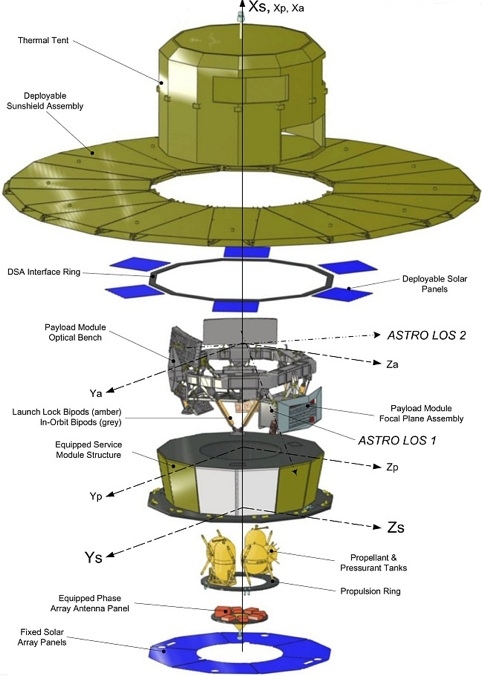
The need to avoid vibration meant that absolutely no mechanical components could be used on the satellite. This, explained Astrium project director Vincent Poisignon, meant that all of the spacecraft’s cooling had to be completely passive: a marked contrast to most of the satellites that Astrium designs and builds, which operate in Earth orbit where they are subject to large temperature swings as they move in and out of sunlight. These incorporate sophisticated systems to shuttle heat away from sensitive components and into structures designed to dissipate energy into space.
Gaia operates in a much more stable temperature environment, but its payload module needs to remain at a constant temperature of -110°C. ‘That’s all done by insulation,’ Poisignon said. ‘The sunshade does a lot of the work, but once the satellite is on station at L2 we just have to wait for the temperature to stabilise. The payload module is thermally separated from the service module, which contains all the fuel and auxiliary systems.’ The satellite’s solar panels are fixed to the base of the sunshield and the bottom of the spacecraft itself.
Orbital manoeuvres
Gaia’s location will give it an unrivalled view of the Earth’s galactic neighbourhood
Gaia is to be stationed at the prime near-Earth point for astronomical observation, the Lagrange 2 (L2) point, 1.5million miles from Earth. Lagrage points occur where the graviational fields of several massive objects — in this case, the Earth, Moon and Sun — are in balance with each other, so a spacecraft can be positioned at them and keep its position with minimal use of thrusters. L2 is attractive for astronomy because it is on the opposite side of the Earth from the Sun, and therefore optical instruments don’t have to cope with solar glare; It is also a stable, and relatively low, radiation environment.
Gaia is equipped with a large sunshield, 10m wide, which sits on the base of the cylindrical body of the spacecraft giving it the appearance of a large hat. At L2, this shades the craft from the light of the Sun, Earth and Moon, keeping the satellite at a steady temperature and providing a stable operating environment for its instruments. The L2 point was also home to the Planck and Herschel space telescopes until they recently completed their missions, and will be the base for NASA’s successor to the Hubble Telescope, the James Webb Space Telescope. But it isn’t a crowded location. In fact, spacecraft orbit around the L2 point in a course known as a Lissajous orbit. In Gaia’s case, this is a key part of the mission. The satellite will spin, scanning its telescopes around a strip of the sky; it will also tumble as it orbits around L2, rotating this strip around the sky to give it a complete view of its surroundings.
The choice of thrusters was also dictated by the need to use no mechanical components. While normally satellites use small chemical thusters — effectively tiny versions of the main engines — this would have generated far too much vibration. Gaia requires constant course correction to keep in its optimum observing position, so ESA decided to develop a new type of cold gas thruster that uses nitrogen as its working fluid. Using piezoelectric actuators to control the flow of gas, these can exert a force as small as a micronewton. ‘You need very little force, but the control has to be absolutely precise,’ Poisignon said. ‘And these thrusters operate constantly; they have to be totally reliable.’
Developed by a division of Thales Alenia Space, which has since been acquired by Selex, the thrusters took eight years to perfect. They are now set to be used on another ESA space-science mission, LISA Pathfinder, which aims to prove the concept behind the LISA mission to detect gravitational waves by monitoring the distances between three satellites flying in closely controlled formation.
Gaia puts Europe at the forefront of space telescope technologies, said Alvaro Giménez, ESA’s director of science and robotic exploration. ‘Gaia builds on the technical and scientific heritage of ESA’s star-mapping Hipparcos mission, reflecting the continuing expertise of the space industry and the scientific community across Europe,’ he said. ‘It’s extremely rewarding to see the next generation of our high-precision observatories built and ready to answer fundamental questions about the cosmos.’
The mapping mission
Gaia will determine the precise position of a billion stars
During its five years operating in space — which could be extended for as long as the spacecraft has enough fuel on board to maintain its observing position — Gaia will carry out a series of studies using its paired telescopes and three on-board instruments. Its primary task will be star-mapping.
The method it will use to determine the precise distance to remote stars is the same one that early naked-eye astronomers, before Galileo, used: parallax. The only direct method for measuring stellar distances, this works by taking measurements from two points, the distance between which is known precisely.
Parallax is best demonstrated by looking at a fixed object with one eye closed, then closing that eye and opening the other. The object appears to move, and the closer it is, the more it moves. Because we can measure the distance between our eyes, we can relate the apparent distance the object moves to the angle at the tip of a triangle formed by both eyes and the object.
Gaia will perform the same calculation by observing that same star at two points of the year, six months apart. The closer the star is, the more its distance will appear to have changed. But because of the vast distances between stars, the parallax angles are tiny — even for the nearest stars, it’s less than one arc-second. This is why precision measurement is so vital for Gaia — the apparent parallax shift for distant stars is minute.
It’s this sensitivity which gives Gaia its exo-planet spotting ability. Strictly speaking, planets don’t orbit stars — stars and planets orbit each other, around a centre of gravity closer to the more massive object. As stars are much more massive than planets, effectively this means that planets make their home stars wobble. Gaia will be able to spot this wobble, analyse it, and by combining this information with the mass of the star, work out how big its exoplanet or planets are, and how far away they are from the star. Gaia is expected to see around 2000 exoplanets.
As well as measuring the distance to the stars, Gaia will also analyse their light using spectrometry. This will yield several pieces of information: the composition of the stars, determined by the characteristic wavelengths that make up their light; their temperature; and their mass.
Another instrument, the Radial Velocity Spectrometry, looks at a narrow range of the spectrum in high resolution to determine their Doppler Shift, which shows how fast the star is moving along its line of sight from Gaia. Because this movement can be ‘run backwards’, it will reveal clues to the galaxy’s history — how the stars moved into the current positions, where they originally formed, and the structure of the galaxy in its youth. And as the movement of stars is influenced by the mass of surrounding bodies, it could also give new insights into dark matter — the mysterious substance which makes up most of the mass of the universe, but emits no radiation and is therefore undetectable directly.
But Gaia’s focal plane array isn’t selective to stars — it’ll see anything that drifts across the telescopes’ field of view. This includes bodies within our own solar system such as comets and asteroids. In particular, it will be able to see asteroids close to the Sun, which ground based telescopes can’t detect; and so-called ‘Trojan’ asteroids trapped in the gravity wells of planets. These could give new information about the formation of the solar system.
Finally, Gaia will give astrophysicsts a chance to for the most extensive test yet of one of Albert Einstein’s theories — the bending of light by massive objects. Stars whose light has to pass close to the Sun and Jupiter is bent by the mass so they appear in a different place from their real position — Gaia will be able to see these effects and quantify the ‘lensing’ effect.




Swiss geoengineering start-up targets methane removal
No mention whatsoever about the effect of increased methane levels/iron chloride in the ocean on the pH and chemical properties of the ocean - are we...